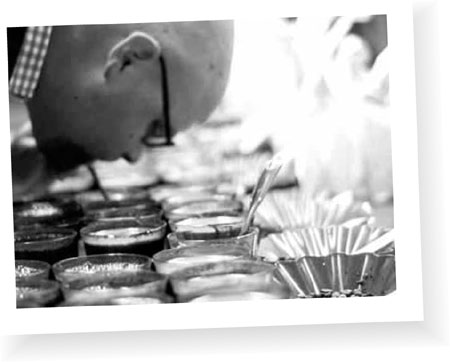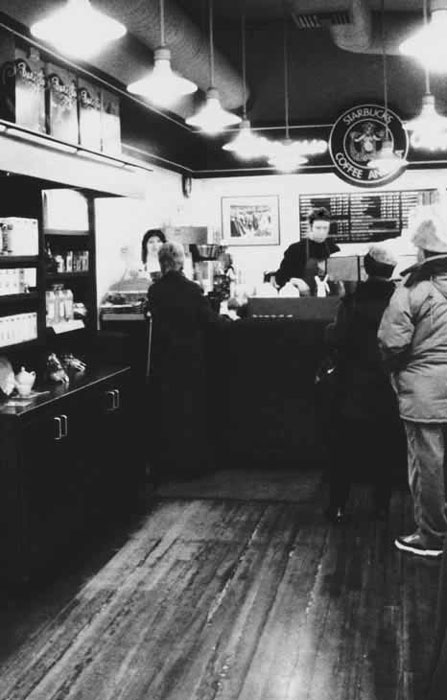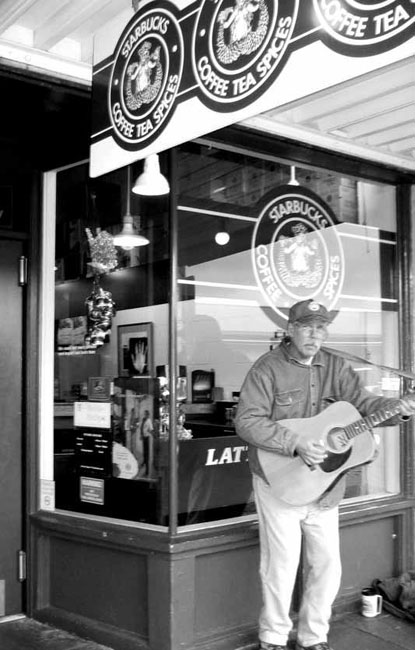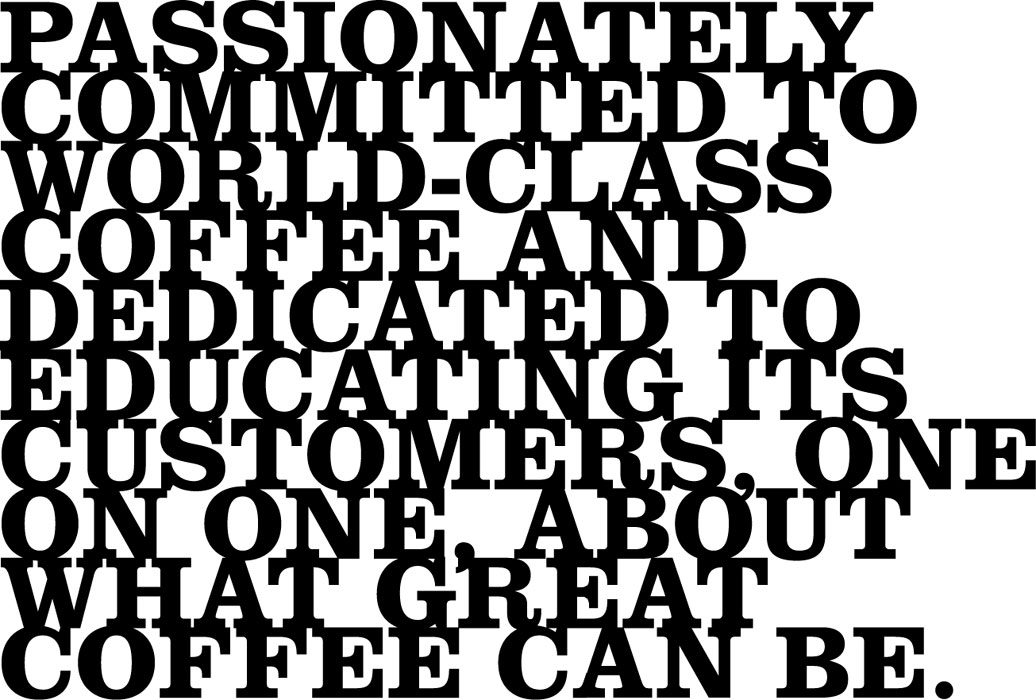Read The Starbucks Story Online
Authors: John Simmons
The Starbucks Story (4 page)
The signs were not good. The local recession was bad enough, but any available research seemed to send out warning signals. Coffee drinking seemed to be clearly in long-term decline. Most companies in the market were competing harder and harder by keeping prices low. Coffee had become the archetypal commodity product.
None of this mattered to Jerry, Zev and Gordon. They were believers. They knew the market outlook was bad, but in their hearts they believed it was because price competition had reduced quality to disastrously low levels. Most of the coffee you could buy was dismal. It was made from cheap beans. It had gone stale on supermarket shelves. Coffee was in a downward spiral created by the big companies who were not giving people the quality of coffee they deserved. Seen in this way, the market actually presented a big opportunity for the kind of business that Starbucks was to be.
Arabica and robusta
Two main varieties of coffee bean are grown today. Both are grown in the tropics because they need warmth and water.
ARABICA
Arabica beans are the traditional coffee beans; indeed, they were the only type available until late in the nineteenth century. Arabica beans grow best on slopes in shade at heights of between 3,000 and 6,000 feet. The higher they grow, the slower their growth and the more flavor they develop. The fuller flavor can be further enhanced by dark roasting. Arabica beans are sold for premium prices because of their relative rarity and higher quality. Starbucks uses only arabica beans to make its coffee.
ROBUSTA
Robusta beans come from a strain of coffee discovered in central Africa just over 100 years ago. Robusta’s advantages are its resistance to disease and its ease of growth at levels below 3,000 feet. It can also be grown in full sun. Its disadvantages are a harsh taste and a high level of caffeine. If you roast robusta beans dark, they will burn, so they are roasted lighter, and that also has the effect of increasing yields because less of the bean’s weight is lost in the process.
Robusta beans cost less to grow and they produce more coffee at growing and roasting stages. As the twentieth century progressed, robusta became used in blends, then became the basis for instant coffee, and then the dominant coffee variety grown and sold worldwide. After years of being banned from coffee exchanges because of their poor quality, robusta beans are now traded as a commodity product with heavy pressure on prices. Farmers of robusta beans have been receiving less and less money for their product.
With their business philosophy agreed, the founders still needed to settle on how they would trade. The word “brand” would not have been used by them at the time, but they had started to build the basis of a brand. As we saw at the start of this chapter, they now had a name: Starbucks. It was a name with romance and resonance, unlike Baldwin, Siegl and Bowker, which had none – unless they wanted to become lawyers. “Starbucks” evoked oceans and foreign lands, and it fitted the sometimes starry-eyed romanticism of their beliefs that their ideas would win in the end.
The name started to suggest visual imagery, too. Terry Heckler was Gordon’s creative partner, primarily responsible for coming up with the name and now the visual identity. Terry researched marine books in pursuit of a tale that would add another layer of meaning.
Moby-Dick
itself, based on whaling, was too dark and bloody. Another mythological archetype jumped out of the research. Terry found a sixteenth-century Norse woodcut depicting a siren, or two-tailed mermaid. It looked intriguing, crafted, adventurous. Like a siren, it was alluring. Placed in a circle, surrounded by the words “Starbucks Coffee, Tea and Spice,” it became the company’s logo.
The store itself, near market stalls where fish were being thrown around, continued the nautical theme. It was designed not to look particularly new. A lot of wood was used, and most of the fixtures were built by hand. The coffee was on display: 30 kinds of bean in containers down one side of the shop. The purpose of the shop was clear: to sell whole-bean coffee. Almost as an afterthought, it seemed, there was space to brew coffee and offer customers samples to taste before they bought bags of beans. These samples were always served in porcelain cups, simply because coffee tastes better out of porcelain. And while customers drank, they could listen to Jerry, Zev or Gordon talking about the coffee. There is no better way to learn than to have to teach, and education was always part of the Starbucks way.

Coffee tastings remain an essential part of working life at Starbucks
Zev was paid to work in the shop through the day: he was the retailer. Jerry carried on working as a teacher by day, learned to do the books by night, and became the real coffee expert. Gordon provided magic, mystery and romance, intuitively knowing that Starbucks was really about much more than an invigorating drink. He and Jerry helped out in the shop at either end of the day. This did not have the appearance of a slick multinational operation in the making.
Alfred Peet was there too, somewhere in the background. Never formally associated with Starbucks, Peet provided spiritual and material aid. To start with, Starbucks ordered its coffee from Peet’s and sold it through the Pike Place shop. Perhaps even more valuably, each of the founders spent time at Peet’s Berkeley shop, learning the trade and the art. They observed the way he passed on his knowledge and passion to his customers, and they learned how to roast arabica beans to a shade as dark as the jungle. Most of all, he made them realize that there would always be more to learn.
The enthusiasm they brought back with them was needed. There was little time for rest. Early on, the
Seattle Times
ran a glowing review, and customers started flocking to the store. After that, word of mouth took over. Within a year, they made two significant decisions to expand the business. First, they bought a used roaster from Holland and installed it in a rundown but affordable building. Once they had worked out how to assemble the machine themselves, they were able to start roasting their own beans. Then in 1972, they opened a second store near the University of Washington. With Peet’s in the Bay Area and Starbucks in Seattle there were now two centers for sophisticated coffee drinking.
It is still worth stressing, though, that this was a retail operation, set up to sell whole-bean coffee for customers to grind, brew and drink at home. To help them do that, Starbucks started selling coffee-making equipment, a decision that later led to a connection with the sales team of one of the equipment makers. But apart from the occasional samples for customers to taste, there was not a coffee-drinking experience in the shops themselves.
It worked. The business grew. Quality spoke loudly, and the word spread. The fanatic for quality was Jerry Baldwin, now working full-time in the company. He made the quality of the coffee his obsession, trusting that everything else would follow from that. There were enough people in Seattle who shared this pursuit of purity to make the business profitable from the start. But expansion beyond Seattle was not on the agenda. Starbucks had discovered a niche and would carry on serving it well within the narrow confines that they had set for themselves. A symbol of this was the Full City Roast, a development of Alfred Peet’s roasting style using arabica beans darkly roasted. It was a small but significant demonstration that they were their own masters now.
The first ten years were successful but relatively uneventful. Progress was made year on year, and Starbucks entered the 1980s with four stores. Zev Siegl decided in 1980 that he would do other things, and left the business. The day-to-day running of the business was mainly in the hands of Jerry Baldwin. Gordon, having given himself license to be the “magic man,” was rather more dilettante in his involvement. He still divided his time between different activities: he ran an advertising and design firm, a weekly newspaper and, in his vision, a microbrewery. Gordon had ideas; Jerry provided focus. “Quality was the whole point,” Jerry said.

The original Starbucks store at Pike Place Market

The Starbucks store at Pike Place today – the only store to keep the original logo
It is worth focusing on some of the principles from those first ten years of Starbucks. It will help us to understand what was really solid and what would be taken forward into the company as it developed. The founders handed down their business philosophy and, although they never wrote it down in this form, it went along these lines:
1.
Every company must stand for something.
(
Starbucks stands for high-quality coffee that is dark-roasted.
) That gives you differentiation and authenticity.
2.
Do not just give customers what they ask for, what they think they want.
(
Starbucks has always tried to educate and develop its customers.
) That gives you loyalty and discovery.
3.
Assume that your customers are intelligent and seekers of knowledge.
(
Starbucks educates its customers and selling happens through education.
) That grows your niche into a mass market.
The interpretation in the last sentence of each of these three points is the message that Starbucks later drew from its founders’ principles. They have served the brand well, and attest to a consistency that has run through the company from 1971 to the present. There has been no need for massive reinvention.
The original Starbucks was a company “passionately committed to world-class coffee and dedicated to educating its customers, one on one, about what great coffee can be.” It had the makings of a great brand, but it might never have grown beyond its product and geographical origins. In 1981 someone entered the scene who loved what he saw in Starbucks so much that he wanted others to share his enthusiasm. Starbucks was not Howard Schultz’s child, but he adopted it from a young age and was inordinately proud of it. What he loved especially was the sense of passion, the commitment to quality and the desire to educate people about the virtues of good coffee. The excitement that Howard felt on his first contact with Starbucks was based on his certainty that it would be possible to do so much more.
It might be important, too, that Howard Schultz was not native to the west coast of the US. He came to Seattle, liked it and stayed, but he never regarded Washington State as the limit of his territory. He knew instinctively that Starbucks would appeal to the world beyond Seattle. He soon reached out to that world.

